List of Authors
>>About this blog
Recent blog post
|
[CAM]
November 30, 2015 20:00
"I don't have any obligation or responsibility to do this, so it's just like retirement. As I sent that day, one of the results of devising various ways to spend money without going out to the world, do not need someone, do not need someone, and swallow yourself alone, was a wandering around the city. " (13-301)
And "Sunday clogs" is a walking note that spells what the wind felt in the daily "hanging walk".
In the "Introduction", "I'm about a year old at the beginning of the summer of 1914, serialized in the magazine Mita Literature every month." It will be a victory view in the city, and it will be a place where there is no trace that has already been destroyed and has no trace. ・・ ・ ・ ・ ・ ・ Based on the idea of the dream world that will be the tide of today's edge, this small book, good luck, can it be a seed of the later day or grass."
Indeed, after that, the Great Kanto Earthquake of 1923 (1923), the U.S. military raid in 1945, and the Tokyo Olympics in 1964, it has been a long time since "the time when this paperboard is formed and it will appear in the world." Now, "I have been able to read this 9th anniversary, and I have already been destroyed.
The scenery in Chuo-ku does not appear so much, but I would like to pick up some of them.
"Edo famous places do not have landscapes or architecture that must be proud of for a long time. ・・ ・ Tsukuda Island, which relocated Sumiyoshi, did not endure the history of Sobashi on a few Kishi Himematsu's shore ... The corner was the only masterpiece of Edo famous places that was only sunny Fuji. . " (300)
"A row of trees is the most effective in downtown areas. Ginza Komagata Ningyocho Dori's willow tree shades and summer night stalls are worthy of a large industrial factory under the Fukidori star without a blowing winder. " (315)
`` Shirakawa Rakuo, a gunshot, is one of the Edo Meien, along with Koishikawa's Korakuen, is one of the Edo Meien, but nowadays the Navy's military members gather and drink. It's a thing of a club that drinks sake. " (320)
"Every time I walked along Nihonbashi Odori and looked at Mitsui Mitsukoshi and other high American-style shops that compete in this area, I knew what a businessman in Tokyo truly called Nihonbashi and Surugacho, if I had a legendary interest in this, I would have even thought of preserving the distant view of Mount Fuji from a busy city. (327)
"In discussing the waters of Tokyo, the first is the sea bay of Shinagawa, the second is the natural river such as the Sumida River Nakagawa Rokugo River, the third is the Edogawa River of Koishikawa, the Kanda River of Kanda, and the Otonashi River of Oji, the fourth is the Shitaya Shinsho Nihonbashi Kyobashi Shitaya, the fourth is the beauty of Shinindigo dyeing. (332)
Walking and walking are now walking in the wind, would it be walking? Kafu still says that he should use money because he has money, but in my case, he said that he has no genuine money, and said, `` As I send that day, I will not go to the public and I will continue to walk around Chuo-ku in the future as a method of swallowing myself without requiring me. "
[Kra-san]
Nov. 30, 2015 12:00
The Doburoku Festival is an event derived from Niiname-no-Matsuri, which appreciates the good harvest of new grains, and was held at Koami Shrine in Nihonbashikoamicho on November 27 (Friday).
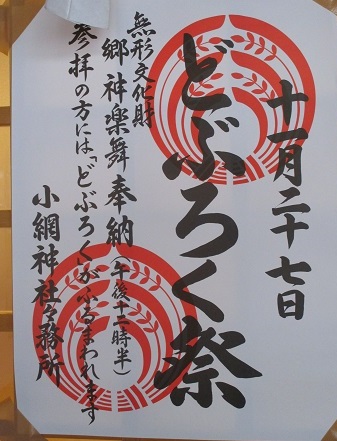 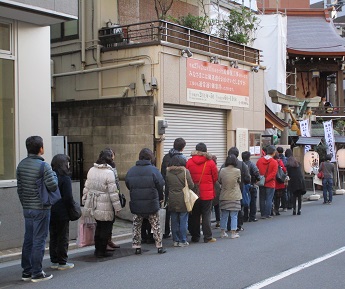 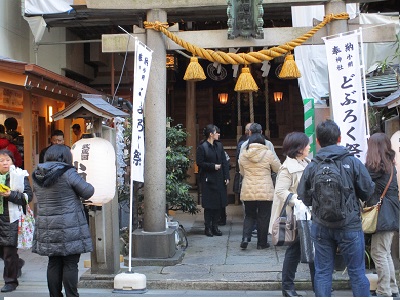
This festival is especially popular as the "Doburoku Festival" because it acts to worshipers in Doburoku (Nigori sake made from fresh rice harvested in the year at Shinryoda), which is offered to Jinmae along with new grains.
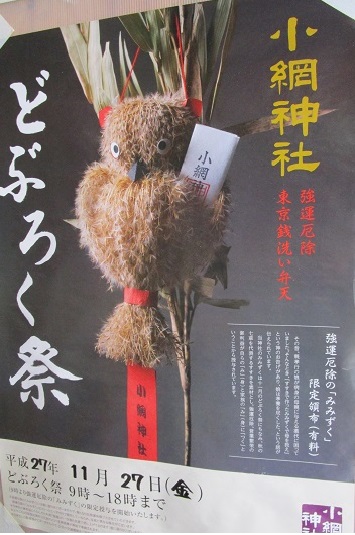 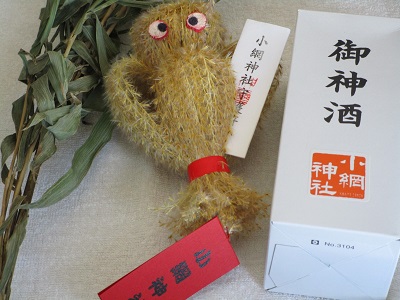
On the day of the festival, a festival was held in shrine hall from 9 o'clock in the morning, and a long line was formed due to the limited distribution of a bottle of sacred wine and the mischief of good luck.
Koami Shrine is enshrined at Koami Manpukuji Temple built in the Muromachi period, and has been worshiped as a god of fortune and prosperity of business, which is said to have originated from Inari Shrine. After the visit, Mr. Miko advised me to doburoku.
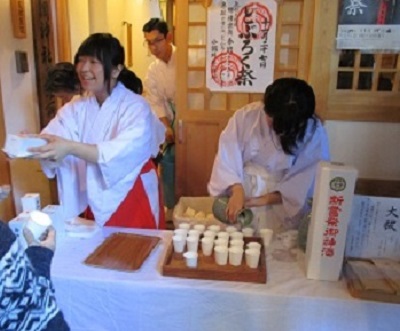
In the past, when the daughter of filial piety was in trouble with the medicine to give to the sick mother, the god told me that `` save the mother with the mizuku made with sosuki ''. It is said that the daughter did filial piety to her mother. "Mimizuku" is based on "Susuki", a representative of the seven herbs in autumn, based on the Doburoku Festival in November, and the benefits of exorcism and thriving business are said to be "Tsuku" to their own "Mi" (body). It seems to have been awarded.
In addition, after noon, "Sato Kagura Dance" from the nationally designated Intangible Cultural Property was dedicated to Kamimae.
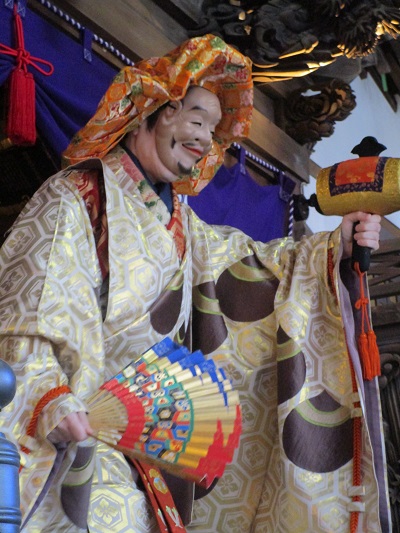
The "Doburoku Festival" next year (2016) of Koami Shrine, one of the two major doburoku festivals in Kanto, will be November 28 (Monday).
[CAM]
Nov. 29, 2015 20:00
Takashimaya Nihonbashi Store (National Important Cultural Property)
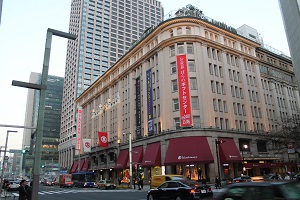
A large-scale department store built in the early Showa period. Orient-like motifs are scattered in the details of classical architecture. There is a cosmetic barrel tree made of terracotta around the eaves, and in the hall on the first floor, you can see a ceiling supported by marble pillars.
Well of Meisui Shirakiya (taken on November 28, 2015, the same applies hereinafter)
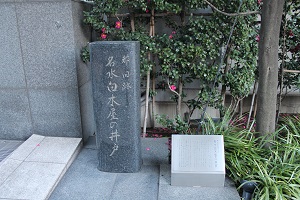
Tokyu Department Store (closed in January 1994), located at the corner of Nihonbashi Intersection, was named Shirakiya until 1958. Shirakiya is a large kimono shop that was founded by Omi merchant Hikotaro Omura and is on par with Echigoya. The water from the well dug by the second generation Hikotaro in 1712 is not only for nearby residents, but also widely It was sung as "Shiraki Meisui". At present, Shiraki Meisui has disappeared, but there is a monument as a historic site designated by Tokyo. (From the tourist association website)
A kite museum
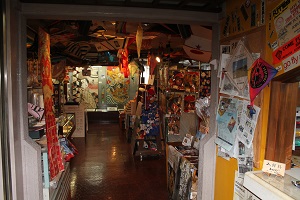
The birthplace of postal mail
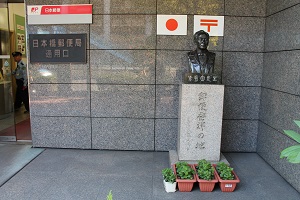
"Currently, the Nihonbashi Post Office is located where Ekiji and Tokyo Post Office were located when the modern postal system was launched in 1871 (1871). Ekiji is a central agency that oversees new telecommunications and postal affairs, and the postal office has been established in Tokyo, Osaka, and Kyoto as its handling agencies. In commemoration of the 90th anniversary of the establishment of postal mail in April 1962, a monument and a bust of Mitsu Maejima (1835-1919), which started the establishment of the postal system, are provided. ]
Chuo-ku Cultural Properties Tour
Chuo-ku Board of Education
Main pillar of Shipping Bridge
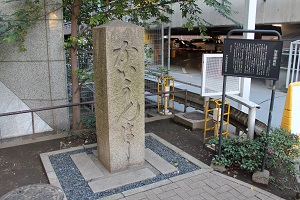
Location 1-20 Nihonbashi, Chuo-ku
The Shipping Bridge is a bridge that was built at the entrance where the maple river joins the Nihonbashi River. In the early Edo period, it was called Takahashi, and the mansion of Shogen Mukai Tadakatsu was placed on the bridge's Higashizume, so it was called Shogen Bridge or Pirate Bridge. The master of the ship was the navy of the Shogunate, and was also called the pirates.
The bridge was renamed the shipping bridge during the Meiji Restoration, and in the same year, it was replaced by an arched stone bridge with a length of eight (about 15 meters) and a width of six (about 11 meters). The area around the Shipping Bridge during the Civilization and enlightenment period prospered as the center of Tokyo's financial services, along with the First National Bank of Japan, which was built in Hashizume, became a new attraction in Tokyo.
Ishibashi was damaged by the Great Kanto Earthquake and was replaced with an iron bridge in 1927. At this time, the main pillars of the two Ishibashi were left as a memorial. The iron bridge was removed in 1962 due to the reclamation of the Kaede River, but this main pillar is registered as a cultural property of the Chuo Ward as a modern bridge remain.
March, 1994
Chuo-ku Board of Education
[CAM]
Nov. 29, 2015 20:00
The birthplace of the bank
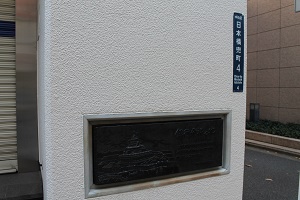
This land was located on June 11, 1873 (1893)
Japan's first bank, Daiichi National Bank, is the first bank in Japan.
It has just been founded.
Established in June 1963
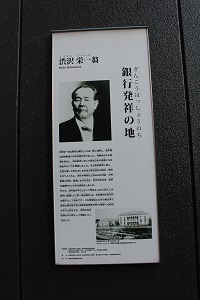
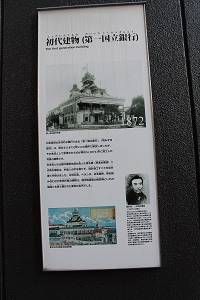
Tokyo Stock Exchange
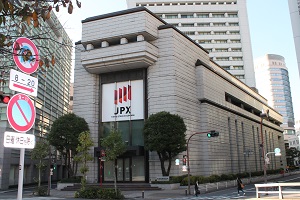
Hie-jinja Shrine
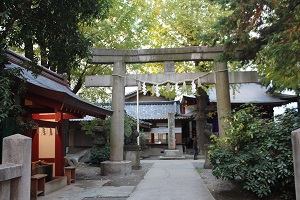
The ruins of the house
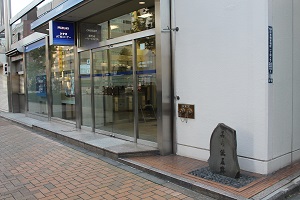
"Kikaku Enomoto (1661-1707) is a high brother of Matsuo Basho. Born in Edo as a child of a doctor serving the Honda family of the Zensho clan, it is said that he entered Basho's gate at the age of 15. He is known not only for haikai, but also for medicine, poetry, Chinese books, calligraphy and painting. It is reported that he died here in Soan near Yakushido hall since the end of the Genroku era. Known as a sake enthusiast, there is a phrase called "Drinking out more than fifteen and today's moon", but there is also a story that Basho is warned of great sake. He is a poet who was familiar to the people of Edo for various anecdotes.
Chuo-ku Cultural Properties Tour
Chuo-ku Board of Education
Chisenin
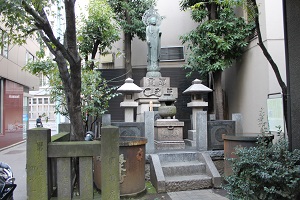
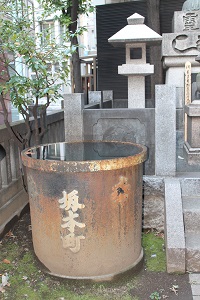
Location 1-5-13, Nihonbashikayabacho, Chuo-ku
main deity Yakushi Nyorai of Chisen-in Temple (Tendai sect) is said to have been made by Sozu Eshin (Genshin) in the middle of Heian, and in the Edo period it was located in Sanno resting place of portable shrines (now Hie-jinja Shrine) as the main Buddha of Sanno Gongen. Due to the abandonment of Buddha in Meiji period, this Yakushi Nyorai is now enshrined at Tokaku-in Temple in Kawasaki City.
Chisen-in is a famous temple widely known under the name of "Kayabacho Yakushi". Ueki City was also opened on the fair, attracting the deep religion of the common people of Edo.
The Tensui bowl in front of Ruriden was dedicated to commemorate the opening of the main deity in 1841 (1841), with the name of Sakamoto (currently Kabuto-cho) and the name of the people who lived in the town. The casting Kamaya Shichiemon was known as Kamashichi, and was a famous founder in Edo. This rain water bowl is registered as a Chuo Ward Cultural Property as a conveying the bustle of the time to the present.
March, 1994
Chuo-ku Board of Education
[Marsha Horiuchi of Edo]
Nov. 28, 2015 14:00
A special exhibition commemorating the 50th anniversary of the Mitsui Bunko and the 10th anniversary of the Mitsui Memorial Museum.
As the second installment in spring, it will be held at the Mitsui Memorial Museum in Nihonbashi until the end of January next year.
During the Edo period, as a Matsuzaka merchant in Ise, he set up a store in Nihonbashi (Otemmacho → Surugacho) and a kimono shop.
And as a money exchanger, through the turbulent period of late Tokugawa shogunate and Meiji, today
It can be said that the traditional heirlooms collected up to the point gathered together.
As if you look at the microcosm of traditional Japanese culture, you can see the tea ceremony, domestic and foreign paintings, calligraphy, and mail.
It is followed by stamps from the beginning of the Meiji era, and the "Yukimatsuzu" of Oukyo Maruyama, a national treasure, and Noh mask.
Why don't you visit as a calming place during the busy year-end and New Year holidays?
12th to 13th centuries of the 13th century, an important cultural property
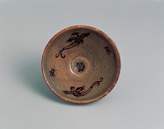 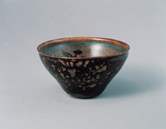
Important Cultural Property Karamono Shoulder Chairi Kitano Shoulder Minami Soong Period, 12th to 13th centuries
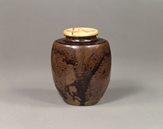
Important Cultural Property Nikko Matsuzuru Figure Screen Muromachi period, 16th century exhibition period January 5-January 23 (left vessel, right vessel)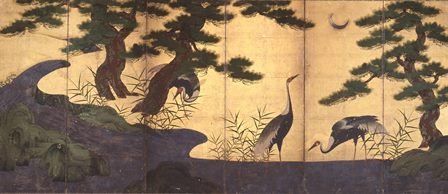
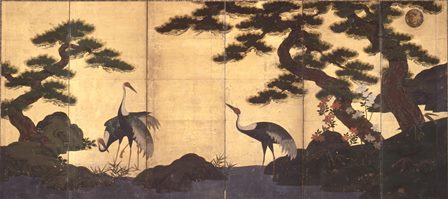
Important Cultural Property Tofukumon-in entrance screen (part) Edo period, 17th century
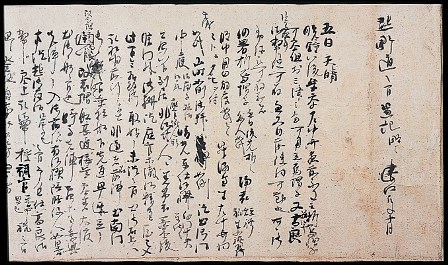
National Treasure Kumano Miyukiki Sadaie Fujiwara brushed Kamakura period, 1201 (1201)
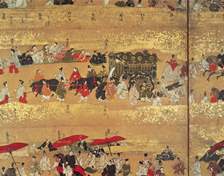
Confucius Temple, Tang dynasty, Jogan 2-4 (628-630)
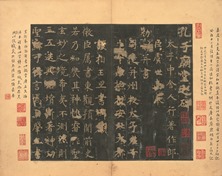
Hand carving stamp Japanese paper cherry blossoms 20 yenMeiji period
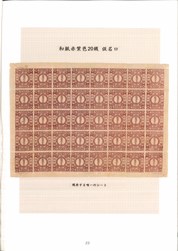
National Treasure Snowmatsu Figure Screen Oukyo Maruyama Brush Edo period, 18th century (left from the top, right)
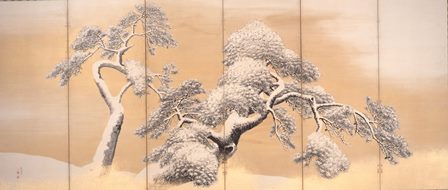
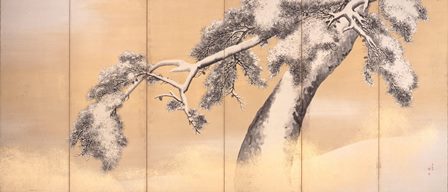
National treasure dagger Mumei Masamune famous Masamune Hyuga Masamune Kamakura period, 14th century

Important Cultural Property Nomen Sonjiro Den Sonjiro's work Muromachi period
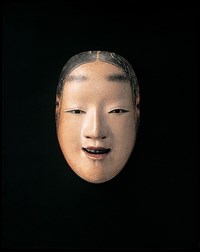
All works will be owned by the Mitsui Memorial Museum.
Mitsui Memorial Museum → The nearest station is Mitsukoshimae Station on the Ginza Line.
Click here for details http://www.mitsui-museum.jp/
※Each image is owned by the Mitsui Memorial Museum. Secondary use is strictly prohibited.
[CAM]
Nov. 27, 2015 12:00
Meijiya Kyobashi Building (Tangible Cultural Property Building designated by ward) 2-2-8 Kyobashi
 (Hereinafter, photos were taken on November 24) (Hereinafter, photos were taken on November 24)
>The Meijiya Kyobashi Building was built in March 1933 as the head office building that also serves as the office and store of Meijiya Co., Ltd. This building is a steel-framed reinforced concrete (8 floors above ground and 2 floors below ground) office building designed by Sone Nakajo Architects, which was called the largest and best design organization in Japan during the prewar period.
It is a valuable modern architecture that reflects the advanced architectural techniques of the early Showa era, along with the excellent architectural design in the Italian Renaissance style. In particular, this building is a rare surviving work created by Tatsuzo Sone, and delicate and splendid decorations are expressed everywhere while removing decorations.
In addition, it is the first private building to connect the basement floor of the building with the subway station, and it is the oldest surviving building integrated with the subway station, historically and culturally It is a valuable building.
The Meijiya Kyobashi Building, which has been preserved to this day after overcoming the Great Tokyo Air Raid and changes in the surrounding environment, is a valuable cultural property that tells the history of Showa and is an important building in the history of modern architecture.
(From the Designated Cultural Property site, Chuo-ku)
Antique street
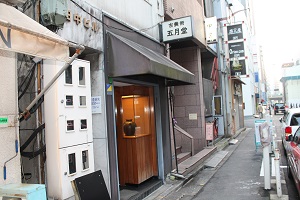
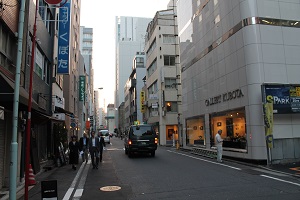
>In 1872 (Meiji 5), railways began to run between Shimbashi and Yokohama, making it easier for local people to travel to Tokyo. However, there is no major transportation from Shimbashi to Nihonbashi, and it seems that it has been a busy street since that time.
The need for antiques and antiques to decorate reception rooms of companies etc. that entered this area before the war has increased, and many antique shops opened from Kyobashi 1-chome to Nihonbashi 3-chome, and now a total of about 150 stores are concentrated.
In particular, the streets of Kyobashi 1-2-chome are called "Antique Street" and attract art merchants and enthusiasts. At the antique festival held in spring and autumn, these stores such as folk art, Chinese pottery, antiques, galleries, etc. will take this opportunity to make it easier for ordinary customers to enter the store. (From the tourist association website)
Utagawa (Ando) Hiroshige residence (Kyobashi 1-9)
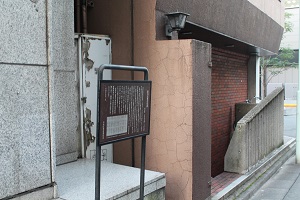
Ukiyo-e artist Ando (Utagawa) Hiroshige (1797-1858) is the residence where he spent about 10 years from 1849 (1849).
Hiroshige was born on the banks of Yaesu (2-chome Marunouchi, Chiyoda-ku) as the eldest son of Genemon Yasuto, a fire extinguisher in the Shogunate, and became a master of Toyohiro Utagawa along with his family. Since "Tokaido Gojusanji", it has become famous as a landscape painter, and Edo has also left "Higato Famous Places", "Higatsukeiyuki Map near Edo", and "Hundred Famous Views of Edo". In particular, "Hundred Famous Views of Edo" is a masterpiece in this area.
It is said that the residence was a two-story independent house located outside the back gate of Kano Nakabashi Yashiki in the Shogunate's Oku painter (Goyo painter) Kano Yotsuya.
March, 1995
Chuo-ku Board of Education
Bridgestone Museum of Art (under construction)
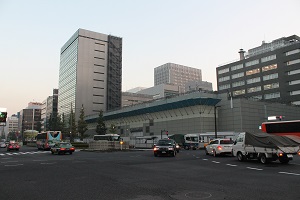
>The Bridgestone Museum of Art is a modern and contemporary Western art centered on impressionist and 20th century paintings.
It also houses Western paintings from Japan since the Meiji era.
In 1952, the founder of Bridgestone Co., Ltd. Shojiro Ishibashi opened an art museum in the newly built Bridgestone Building and released his collection.
The Ishibashi Foundation was established in 1956, and in 1961, most of the works of art owned by Shojiro were donated to the Ishibashi Foundation, forming the core of the current collection.
"For the pleasure and happiness of the people of the world," this is the motto of Shojiro Ishibashi.
This is the basic philosophy of the Bridgestone Museum of Art.
Since its opening to the present day, the Bridgestone Museum has been working to enhance its collection through continuous collection activities, holding various themes of special exhibition, holding lectures and educational programs, and publishing books.
We will continue to provide opportunities and opportunities for people to meet, enjoy, and learn outstanding works of art, and contribute to the promotion of mutual understanding of human beings and the development of arts and culture in modern times.
Currently, the museum is closed for the construction of the New Museum, but research activities, collection activities, and educational dissemination activities will continue even during the museum's closed.
At the time of the opening of the New Museum, I would like to present the museum image suitable for the 21st century to everyone in an easy-to-understand manner. (From the museum site)
|
Links
|


















